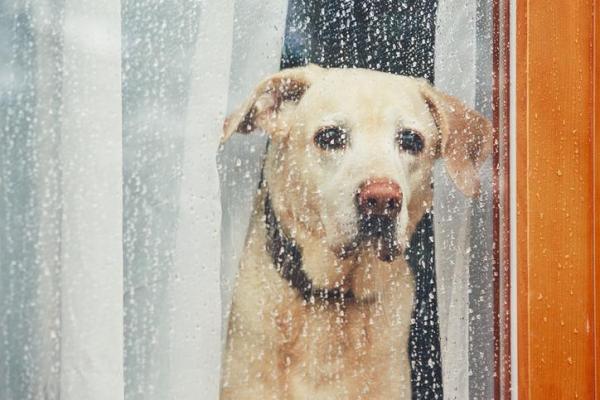How to Spot and Treat Depression in Dogs



See files for Dogs
Dogs, like humans, can exhibit signs of depression. While they can’t verbally express their emotions, their behavior can offer clues. Common signs include decreased interest in activities, changes in sleep or appetite, lethargy, and withdrawal. If you suspect your dog might be depressed, it’s crucial to consult with a veterinarian. These symptoms can also be associated with underlying health issues. With proper diagnosis and care, dog depression is often treatable.
In this AnimalWised article, we’ll explore the symptoms, causes, and treatments for dog depression.
How can I tell if my dog is depressed?
Depression in dogs can manifest in various ways, and while symptoms may differ from one dog to another, these are the most commonly observed signs:
- Reduced activity levels.
- Decreased social interactions with other dogs and people.
- Loss of interest in surroundings and previously enjoyed activities.
- Eating disorders, ranging from loss of appetite to overeating.
- Lethargy, apathy, and a tendency to lie down for extended periods.
- Increased sleep, though some dogs may experience restlessness and sleep less.
- Vocalizations such as moaning, crying, or howling without an apparent cause.
- Seeking solitude or hiding in quiet places.
- Reduced affection or engagement with owners.
- Behavioral changes, including a loss of playfulness.
- Slow or sluggish movements.
- Possible incontinence or lack of control over urination.
- Stereotypical behaviors, such as repetitive licking or biting of paws.
- Some dogs may show signs of anxiety or even aggression.
Wondering why your dog reacts aggressively to some people? Dive deeper into this behavior and learn how to address it in our related article.

Types of depression in dogs
Depression in dogs, like in humans, can be classified into two primary types based on the cause: endogenous depression and exogenous depression. These two categories help explain whether the depression originates from within the dog's biology or is caused by external environmental factors. Here’s a deeper look at each:
Endogenous depression
This type arises from internal or biological factors, is not breed-specific and can affect any dog, whether purebred or mixed-breed.
Certain medical conditions can lead to a depressive-like state. For example, hypothyroidism, neurological disorders, chronic pain, or conditions like Cushing's disease can trigger symptoms similar to endogenous depression.
Aging dogs may also experience changes in brain function, such as cognitive dysfunction syndrome, which can result in depressive symptoms.
Exogenous depression
This type is more common and triggered by environmental factors such as changes in routine, loss of a companion (human or animal), trauma, or other external events.
Dogs that have experienced traumatic events, such as abuse, abandonment, or being rehomed, are more likely to develop exogenous depression. Even something as simple as a loud noise or negative experiences at the vet can act as stressors leading to depressive behaviors.
Furthermore, some dogs are sensitive to changes in weather or seasons, just like humans with seasonal affective disorder (SAD). A decrease in daylight hours during winter, for example, can lead to lower activity levels and mood swings in some dogs.
Depression in older dogs
In senior dogs, depressive symptoms may be linked to cognitive dysfunction syndrome (CDS), a brain-aging process similar to Alzheimer's in humans. CDS results in a gradual decline in mental faculties, with symptoms like disorientation, house soiling, repetitive behaviors, decreased interaction with family members, and disrupted sleep patterns.
This cognitive decline can sometimes occur alongside medical conditions like kidney disease, so it's essential to visit the vet for a thorough evaluation to rule out physical causes. Age should not be a barrier to seeking treatment for your dog’s symptoms.
If cognitive dysfunction is diagnosed, treatment may involve a combination of environmental enrichment, behavior modification, and, in some cases, medication. Collaborating with a veterinarian or a canine behavior specialist can help tailor a plan to slow cognitive decline and improve your dog's quality of life.
As your dog ages, their needs change dramatically. Discover expert tips on how to keep your senior dog healthy and happy in our related guide.
Causes of depression in dogs
As mentioned earlier, there are several situations that can contribute to depression in dogs, common reasons include:
- Separation anxiety: a common cause of depression, where dogs develop depressive, disruptive, or destructive behaviors when left alone at home for long periods.
- Grief from the loss of a companion: just like humans, dogs can mourn the death of a companion, whether another dog or even a pet of a different species. The loss of that emotional bond can lead to symptoms of depression.
- Moving or family changes: sudden changes in environment, such as moving to a new home or the arrival of new family members (both human or animal), can disrupt a dog’s routine. This may cause depression, and they’ll need time and proper stimulation to adjust.
- Chronic stress: situations involving ongoing stress, such as household conflicts, fights with other animals, or chronic illness, can trigger depression. Addressing the root cause is crucial for the dog’s recovery.
- Poor socialization: dogs that have been separated from their mother and littermates too early or have suffered abuse may develop behavioral issues, including depression, due to a lack of proper socialization during critical periods of their development.
- False pregnancy in female dogs: unspayed female dogs can experience a hormonal shift after heat, mimicking pregnancy despite not being fertilized. This can trigger maternal behaviors and depressive symptoms. On the other hand, dogs don’t typically experience postpartum depression, so if a dog seems depressed after giving birth, a vet visit is essential as it could indicate illness.
Curious about unusual health conditions in dogs? Learn how phantom pregnancies can mimic real ones and what to do if your dog shows these symptoms.

How to treat depression in dogs?
If your dog shows signs of depression, it's essential to visit the vet to rule out any underlying physical health problems. Once depression is diagnosed, identifying the root cause is crucial to improving your dog's mental health. From there, you can introduce changes to help boost their mood, as we’ll discuss in the next section.
For more complex cases, consulting a behavior specialist, such as an ethologist or a veterinarian with expertise in canine behavior, can be helpful. They can guide you in adjusting your dog's environment and modifying their behavior. In severe cases, your vet may also prescribe medication to support your dog’s recovery and overall well-being.
How to cheer up a depressed dog?
Regardless of the cause of your dog's depression, there are several steps you can take to help improve their mood:
- Spend dedicated time with your dog every day. Dogs are social animals that thrive on feeling part of the family, so regular interaction is vital to their emotional well-being.
- Ensure your dog gets sufficient exercise, including walks that go beyond just bathroom breaks. Engage them with games, obedience training, and other stimulating activities to keep them entertained and mentally active.
- In some cases, introducing a new dog can help lift the spirits of a depressed dog. However, this decision should be made with caution, as it can sometimes worsen depression. Consulting a professional, such as an ethologist or vet, is highly recommended before making this choice.
- Avoid leaving your dog alone for extended periods, as isolation can worsen depressive symptoms.
- Try to minimize stressful situations that could aggravate or prolong your dog's condition. Keeping a calm and stable environment is important.
- Use adaptation techniques based on guidance from a veterinarian or behavior expert to help your dog adjust to any changes.
- While products like pheromone diffusers or Bach flowers have shown only a placebo effect, they can still be used if you feel they might offer comfort.
- If your female dog suffers from recurring false pregnancies, spaying can help prevent these episodes and the associated depression.
Always seek professional advice when dealing with a dog's emotional health to ensure the best approach for their recovery. Looking for ways to lift your dog's mood? Try incorporating some mental exercises! Explore creative games to keep your dog’s brain sharp and engaged.

This article is purely informative. AnimalWised does not have the authority to prescribe any veterinary treatment or create a diagnosis. We invite you to take your pet to the veterinarian if they are suffering from any condition or pain.
If you want to read similar articles to How to Spot and Treat Depression in Dogs, we recommend you visit our Mental problems category.








